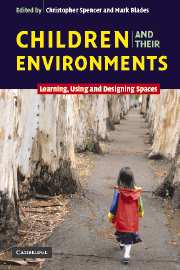Book contents
- Frontmatter
- Contents
- Notes on contributors
- An introduction
- Part I Children's understanding of places
- Part II Children's experience of places
- 5 Learning neighbourhood environments: the loss of experience in a modern world
- 6 The classroom environment and children's performance – is there a relationship?
- 7 ‘Sometimes birds sound like fish’: Perspectives on children's place experiences
- 8 Is contact with nature important for healthy child development? State of the evidence
- 9 Environmental child-friendliness in the light of the Bullerby Model
- Part III Adolescents' worlds?
- Part IV Children and the design process
- Index
- References
6 - The classroom environment and children's performance – is there a relationship?
Published online by Cambridge University Press: 23 October 2009
- Frontmatter
- Contents
- Notes on contributors
- An introduction
- Part I Children's understanding of places
- Part II Children's experience of places
- 5 Learning neighbourhood environments: the loss of experience in a modern world
- 6 The classroom environment and children's performance – is there a relationship?
- 7 ‘Sometimes birds sound like fish’: Perspectives on children's place experiences
- 8 Is contact with nature important for healthy child development? State of the evidence
- 9 Environmental child-friendliness in the light of the Bullerby Model
- Part III Adolescents' worlds?
- Part IV Children and the design process
- Index
- References
Summary
Introduction
When we go into a classroom, what do we see? Busy people, some chaos and a lot of activity like sitting, standing, moving, and talking, some might be in silence, writing, drawing, pointing, singing, fidgeting, crying, laughing, whispering, or sleeping. But one person (the teacher) seems to be dominating the setting and communication seems to be always present, either by talking or writing, or through gestures like the raising of an arm (Adams and Hiddle, 1970). A classroom environment is much more than a place to house books, desks, and resources. It is a place for learning.
This chapter will examine the current literature on the impact of the classroom environment on performance. There still seems to be a lack of research in educational settings that looks into the school environment and children's performance. The investigation into the physical environment's influence on learning outcomes has been largely ignored, or maybe avoided, in favour of research into other areas within the school, for instance, pedagogical, psychological, and social variables. What is surprising though, is that children spend most of their waking hours in school and that should in itself prompt investigation into the impact the physical environment has on them.
Since 2001 the UK Government seems to be finally recognizing the importance of the environment in raising standards (Clark, 2002). Clark cited the following by David Blunkett, Secretary of State for Education and Employment:
Getting the basics right is not just about literacy and numeracy – it also means putting the right facilities in place so that teachers can teach and children can learn.
(January 2001)- Type
- Chapter
- Information
- Children and their EnvironmentsLearning, Using and Designing Spaces, pp. 91 - 107Publisher: Cambridge University PressPrint publication year: 2006
References
- 17
- Cited by



